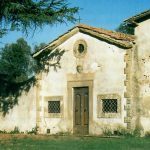Probably in the second half of the 16th century, the first significant “country houses” were built, mostly associated with large landowners from Florentine families. The first systematic expansion of inherited properties is credited to Filippo Peruzzi, whose estates grew from Penna toward Monsoglio, an area where there was likely a “worker’s house” and an inn near the aforementioned and now disused small hospital, owned by Niccolò, son of Sebastiano from Florence, who, however, resided in Laterina.
From 1590 until 1617, the widow of Filippo, Camilla Capponi, continued to expand the Monsoglio estate through the acquisition of lands primarily located in the direction of Rondine. Later, the third phase of expansion and consolidation of the estate, which took place during the 17th century, was carried out by Francesco Carlo, Giovan Filippo, and Bindo Peruzzi. Between 1662 and 1694, Giovan Filippo di Giovan Battista Peruzzi, a canon of the church of Santa Maria del Fiore in Florence, undertook an extensive campaign of acquisitions aimed at further expanding the Monsoglio estate towards Rondine. It is only in 1682 that the property is explicitly referred to as the “villa of the Peruzzi family” in Monsoglio.
Between the years prior to 1694 and 1710, the most significant transformations of the Monsoglio villa took place, commissioned by Bindo Peruzzi. First and foremost, he oversaw the creation of an even more monumental staircase, scenographically Baroque, which provided access to the noble floor from the front lawn, crowned by three gates. The façade was characterized by elegant windows and French doors, framed by a false ashlar band, still reflecting the style of the early 16th century.
From the large hall, the core of the villa, the building’s decorative painting seems to have begun (with an Olympus of the Gods and some Moorish telamones), perhaps as early as the early 1690s, when Giovan Filippo was still alive. These paintings can be attributed to Atanasio Bimbacci (Florence 1649–1734), and are similar to those of the Aretine artist Giovan Battista Biondi.Certainly, after the death of his uncle, the canon, the expansion of the villa on both sides can be attributed to Bindo Peruzzi. This included the addition of an alcove on the right and a gallery on the left, featuring eight doors topped by rich decorative painting, with broken and inverted segmental pediments and central oval medallions bearing the ‘historicist’ portraits of eight of the nine gonfalonieri of the Peruzzi family. These paintings are attributed, albeit with some reservations, to Giovan Camillo Ciabilli (1675–1746).It is likely that during these years, the Italian-style garden at the rear of the villa was also laid out.
After a bitter dispute among the various members of the Peruzzi family over the ownership of the Monsoglio estate (1718–1722), Bindo di Bindo Bernardo became the new and sole owner.In 1744, the complex was sold at auction to Marquis Francesco Pier Maria di Alessandro Capponi (1688–1753). Between 1746 and 1748, some works were carried out at the villa, including the fresco decoration of the main alcove, which was perhaps completed only in the second half of the 18th century by Giuseppe Nobili, commissioned by the marquis’s son, Alessandro Maria.In 1788, the estate passed to Pier Roberto di Gino Capponi (1752–1825), and in the following years, the entire estate underwent an agricultural reorganization, a process that continued until the Restoration period.
In 1825, the villa of Monsoglio was inherited by Gino Capponi (1792–1876), the renowned scholar, writer, moderate liberal, and Florentine patriot, friend of Foscolo, Manzoni, and Leopardi. Capponi was also the camarlingo (treasurer) of the Community of Laterina. Upon Capponi’s death in 1876, the villa and the farm passed to his daughter Ortensia degli Incontri and then to his grandson, Carlo Incontri, who sold it in 1884 to Marquis Francesco di Giovanni Pasquali Da Cepperello. At the time of the sale, the estate consisted of the “villa, nine farms, and adjoining woodlands.” Beginning the following year, the estate underwent a new phase of significant expansion.It is likely that the planting of the four pyramidal Lebanese cedars in the lawn in front of the villa dates back to the early years of the new owner’s possession.
In 1912, Marquis Augusto Pasquali Da Cepperello (1884–1972) inherited the assets of his father, Francesco. Between 1909 and 1915, the young Augusto—therefore, even before officially becoming the owner of Monsoglio—began restoring and beautifying the old villa, including, among other things, the creation of the billiard room. The garden, which had perhaps been partially transformed into a vegetable garden before 1850, was also redesigned, and various furnishings were added, such as terracotta lions, statues, and lemon tubs. The chapel, located to the left of the villa, was also restored.
In 1924, the “tabaccaia” (tobacco drying shed) was built not far from the villa. By that year, the Monsoglio estate had reached a size of 400 hectares, half of which were devoted to cultivated and vineyard land, while the other half was used for pasture and woodland. Between the two World Wars, the most important and expensive works at Monsoglio (on the farm and in the various farmhouses) were carried out by Augusto Pasquali, whose estate then included 20 farms operated under sharecropping.The years around the war and the post-war period, up until the 1950s, represented the peak of expansion and prosperity for the estate. The historical significance of the villa was officially recognized on June 25, 1945, when it was placed under protection by the Superintendency for Monuments of Florence.In 1972, upon Augusto’s death, the estate passed to his daughter Patrizia, married to Mosiici (1924–1997). Since 1997, the villa has been inherited by the Mosiici family; no longer inhabited and in a state of severe disrepair, the building is not open to visitors.









